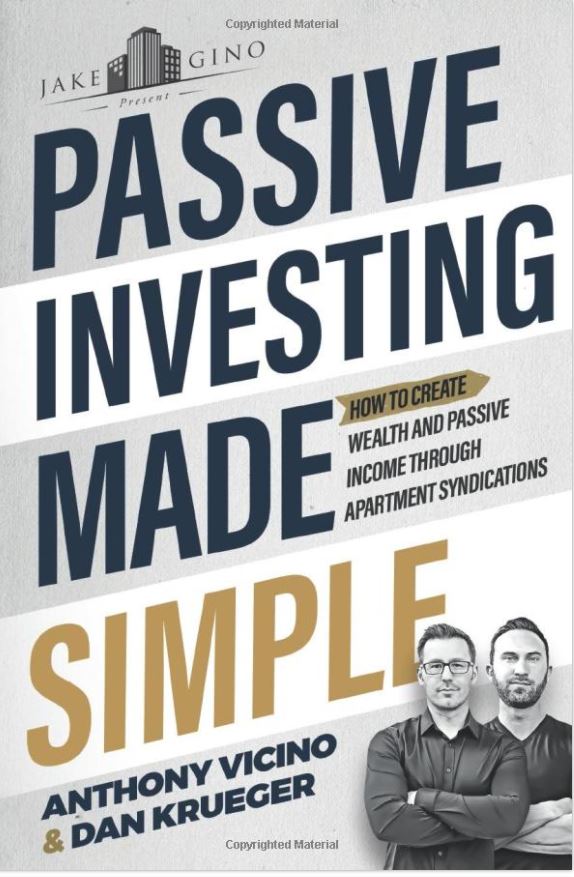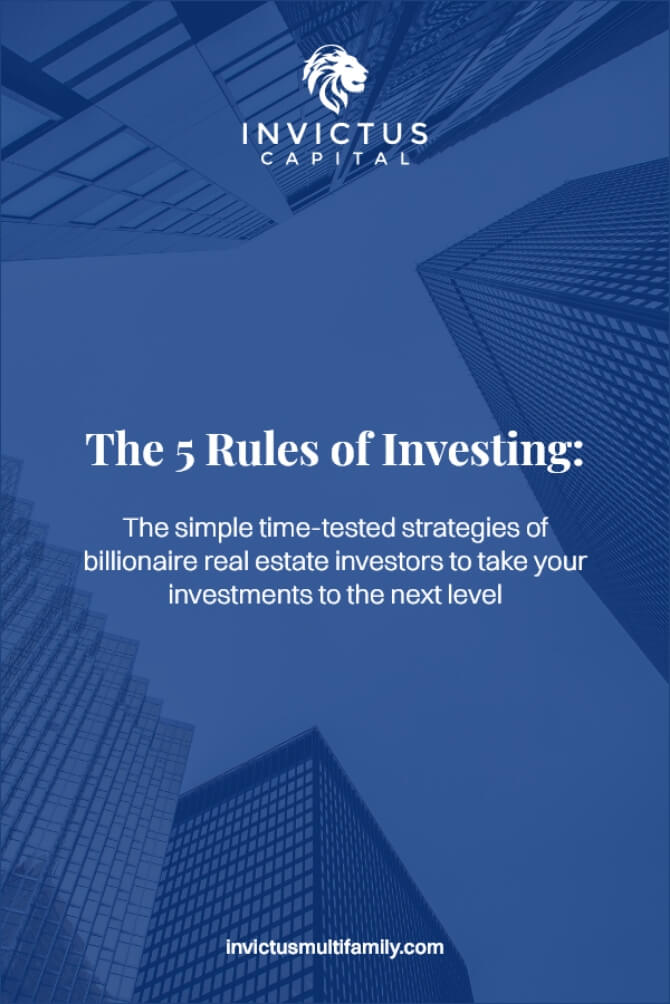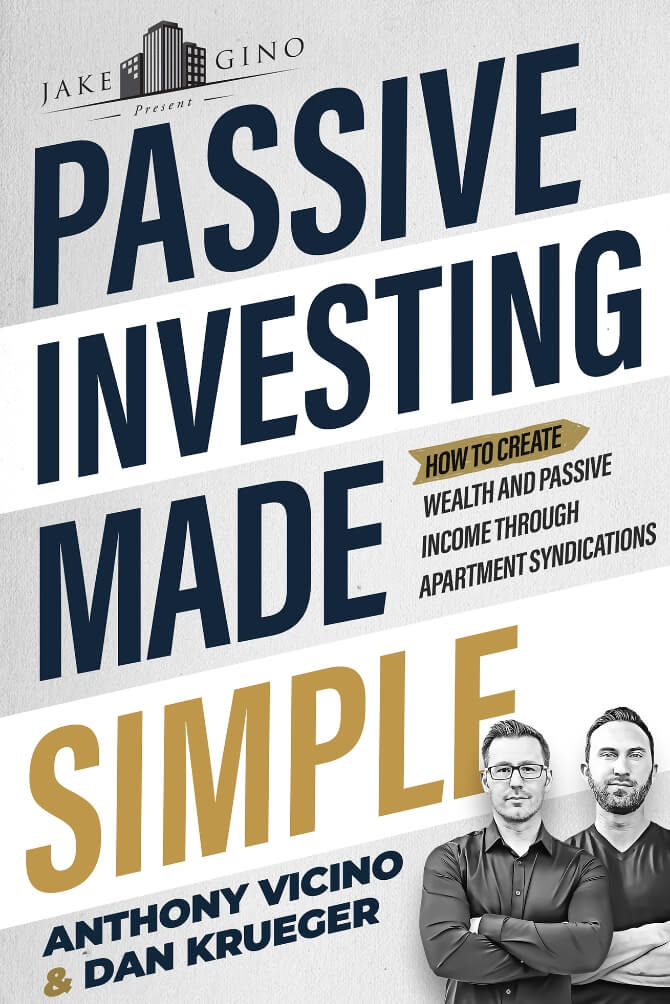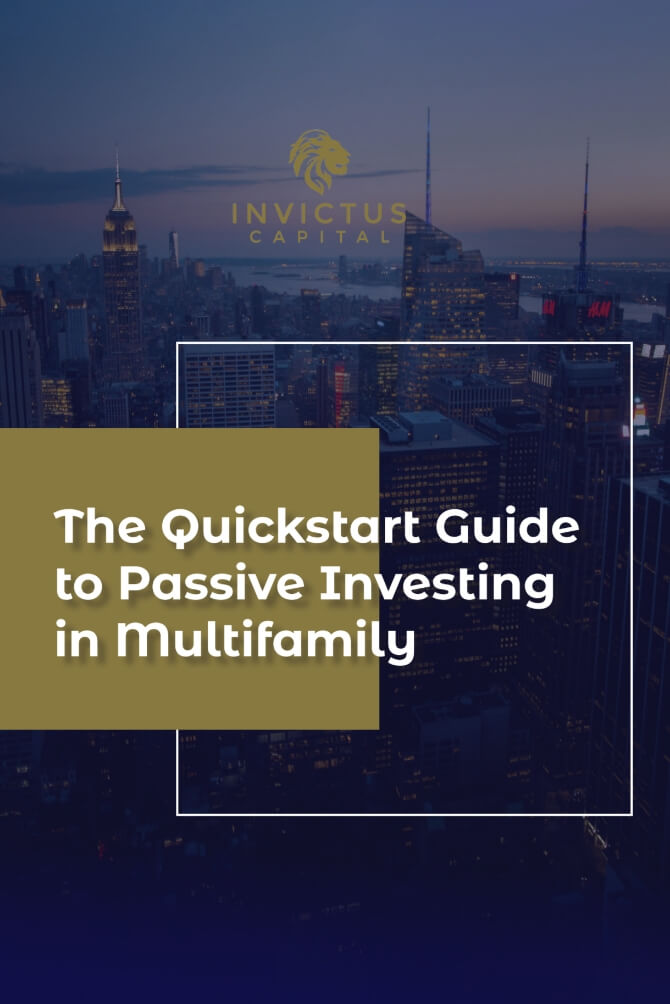For today’s episode, we will be talking about three ways to value a building.
This is top of mind for Invictus Capital right now because we just had the appraisal come back on a building, which it came back around $200,000 more than what we have it under contract for.
We will talk about these things…and more in another episode of Multifamily Investing Made Simple in under 10 minutes.
The audible version Passive Investing Made Simple: How to Create Wealth and Passive Income through Apartment Syndications is LIVE!!
Tweetable Quotes:
“The income approach is the bread and butter of the commercial real estate, whether it’s apartments or industrial or retail-like, it’s how you value a business” – Dan Kreuger
“What’s interesting about the appraisal reports is that the cap rates are derived in a couple of different ways. They look at past sales, they’ll look at local opinions, so they’ll go, and like you report some brokers, they’ll look at reports.” – Anthony Vicino
LEAVE A REVIEW if you liked this episode!!
Keep up with the podcast! Follow us on Apple, Stitcher, Google, and other podcast streaming platforms.
To learn more, visit us at https://invictusmultifamily.com/
**Want to learn more about investing with us?**
We’d love to learn more about you and your investment goals. Please fill out this form and let’s schedule a call: https://invictusmultifamily.com/contact/
**Let’s Connect On Social Media!**
LinkedIn: https://www.linkedin.com/company/11681388/admin/
Facebook: https://www.facebook.com/invictuscapitalventures/
YouTube: https://bit.ly/2Lc0ctX

How to Value A Building
Anthony Vicino: [00:00:15] Hello and welcome to multifamily investing made simple, the podcast, it’s all about taking the complexity out of real estate investing so that you can take action today on your host. Anthony Vecino of Invictus Capital, joined as always by Dan. He has more than four percent battery life on his remarkable left Kruger.
Dan Krueger: [00:00:32] I feel battery-rich compared to you right now.
Anthony Vicino: [00:00:35] Your battery broke. I’m anemic. I’m looking down at my, my electronic paper and you know, the great. So I’m all about tools and software and hardware, like in headphones like gadgets. We love gadgets and we have these gadgets, these Remarkables, and they’re really just digital paper. It’s an Etch-A-Sketch. It’s an Etch a Sketch for adults, and it’s great for note-taking. I recommend a highly it’s a great device, and yet my battery is about to die and I’m reminded it is not in the paper, never runs out of batteries, right? So but it does run out of ink, I guess De Pen does. So anyway, we have officially blown one minute of this 10-minute episode on the banter. Now it’s time to get into the meat and potatoes, so let’s talk about three ways to value a building. This is top of mind for us right now because we just had the appraisal come back on a building, which it came back for like 200000 more than what we have it under contract for. So huzzah, that always feels really good to know that you got some baked-in equity from day one. But as you go through the appraisal report, which is often a pretty dense appraisal report, there’s a lot of really good information in there and you’ll notice that there are a couple of different ways that the appraisers use to value a building, and then they kind of take this weighted approach to figuring out what the final number is going to be. And so we thought it’d be interesting to talk about what those three methods are today. So, Dan, what’s number one?
Dan Krueger: [00:01:57] Yeah. So number one, I guess, would be the number one. The number one in our list is probably the one that most people think about because it’s what gets talked about. But for those passive investors out there, you might not have seen these reports before, so you might not be aware that there’s actually a couple of different things they’re looking at. So the number one way, the one that matters the most, which are knock-on first, is the income approach. And that’s where the appraiser is going to take a look at the rent roll and all the income for the property. And the expenses are going to look at the P&L and they’re going to find out what that NOI is and we’re going to apply a market cap rate to that NOI to to to derive a value. And that is what we talk about all the time on this show because it’s an amazing way to value property because it’s very black and white. It’s quantitative, it’s not subjective. It’s something we could wrap our heads around and not have to worry about. Some, you know, market emotional nuances negatively impacting our value as you get in smaller properties where it’s all based on comps. So the income approach is, you know, the bread and butter of the commercial real estate, whether it’s apartments or industrial or retail-like, it’s how you value a business because when you’re buying a business, whether it’s an apartment or hardware store or McDonald’s, you’re buying the cash flow, right? You’re buying a machine that spits out X number of dollars every month and you’re paying a certain price based on how much money that’s been.
Anthony Vicino: [00:03:17] That’s basically it. Hmm. Yeah. And so within the income approach, you know, to value a building, it is a simple formula which is in a way which is our net operating income divided by the cap rate. And so the NOI is the delta between our revenues minus our expenses, and that’s going to be your profits. So in a way, now the cap rate was really interesting in these appraisal reports is they have a couple of different ways that they come by the cap rate and we’re not. This episode is not going to dive into what exactly the cap rate is, that kind of complicated topic. We’ve done other podcast episodes on this, so go look at those up. But just generally, the cap rate is a sentiment of market sentiment. It’s a mark of market sentiment. You guys might have thought that my phone just rang. I should have put that in silent mode, so I apologize for that for the listeners at home. It’s live. Yeah. So but what’s interesting about the appraisal reports is that the cap rates are derived in a couple of different ways. They look at past sales, they’ll look at local opinions, so they’ll go, and like you report some brokers, they’ll look at reports. Yeah. And so that is kind of a comparables technique there where they’re looking at what’s the cap rate. So that’s the most important thing when it comes to valuing a multifamily building. But it’s not the only thing I would say. It’s, what, 80, 80 percent ish.
Dan Krueger: [00:04:35] Yeah, it really I think it depends on the appraisal we’ve had, you know, several over the years what I can tell. When they weigh the value they come up with, they typically apply about 80 percent of the value to the income approach. And then there’s another approach that they use that can some kind of sometimes get factored in by about 20 percent. And then the third one we’re going to get to
Anthony Vicino: [00:04:54] I Will probably not factor in too much. So the number two thing, and if you own a single-family home or like a primary residence or a duplex, you’re going to be more familiar with this form, which is comparables. And that is you’ve heard my story before. I owned a triplex, my first property that I actively managed, and it appreciated by one hundred and twenty-five thousand and nine months. It was not because. As I added more income or decreased expenses, it was merely because all the houses around me were selling for a lot more than what I had paid for mine. And so based on comparables in what other buildings of a similar build are selling for, that’s going to derive the value of your building.
Dan Krueger: [00:05:32] Yeah, which worked out well for you because you got some appreciation out of it. But what is can be aggravating or frustrating, which it was for you because it was a catalyst for you to kind of switch to a different type of product was that could have easily gone the other direction and it was completely out of control. It doesn’t matter how much money you put in, it doesn’t matter how much money the property is producing. It’s what Gary sold his house for down the street that’s really going to impact you. And what if Gary’s having a bad day and decides to sell his house at a 50 percent discount? Yes, he’s lost his mind.
Anthony Vicino: [00:06:01] I mean, Gary could have all sorts of reasons maybe could hit him. He was a service worker. He’s out of a job. He can’t hit his. He can’t, he can’t make his mortgage payment anymore, so he gets foreclosed on. Like, there are all these strings of things that could affect the value of your home. And in large multifamily, they do still use comps a little bit, but it really only accounts for maybe 10 to 20 percent of the overall weighted valuation that you’re going to see on appraisal. And so those are the two primary. We’ve got our income approach and we’ve got our comparables approach and the third approach, which doesn’t really get used in the appraisal, but maybe does come in handy if you’re building ever burns down.
Dan Krueger: [00:06:39] Yeah, no. I think, yeah, I was going to say it’s used in other classes of multifamily more readily, I think because it’s more applicable. Mm-hmm. Right. Yeah, I’ll get to why in a sec when we break the news on what it is. So what is it, Dan? Oh, my goodness replacement cost. So for our properties, we’re buying these things in our area. Four hundred-one hundred and twenty, maybe one hundred and fifty thousand per door to build a new building to replace one that burnt down. It’s two hundred and two-fifty a door, right? So that component doesn’t really matter. Yeah, you
Anthony Vicino: [00:07:13] Couldn’t build it. First of all,
Dan Krueger: [00:07:14] Can’t it’s too expensive to build these days, so you can’t create the same thing? You’re going to be creating a different thing. So the replacement cost for us is, I mean, sometimes an appraiser will throw something on there, I think. But nine times out of 10, I’d say nine points nine times out of 10, it’s completely disregarded. Now, if you’re going to be buying the new construction, I’m guessing that replacement cost is going to be a bigger factor. But for us, it’s kind of a non-issue. It’s an issue on the insurance that we want to make sure that your insurance has that appropriate replacement cost so that if it does burn down if your building does burn down, you’re good. But as far as the value in the property and determining what you’re going to pay for it when you buy it, it’s almost a non-issue.
Anthony Vicino: [00:07:50] And that’s an important thing. Let’s just point this out real quick has nothing to do with the valuation of the building for the bank’s purposes. But from an insurance perspective, if if you only insure your building for the replacement cost of what you paid for it, well, that’s not going to be enough because you’re not going to be able to build that building for that amount.
Dan Krueger: [00:08:07] So you want to build it again.
Anthony Vicino: [00:08:08] Yeah. And maybe you just want to take the payout and walk away, like there are all sorts of different, you know, options for different folks. But if your plan is if you’re disappointed by your building burning down and you’re like, I would like to have my building back, well, you better really hope that you insured it at the actual replacement cost, which is going to be a higher premium. So that’s another topic for an entirely.
Dan Krueger: [00:08:26] Actually, not that honestly, on the stuff we’ve done, I’ve looked at different scenarios, and trying to skimp on the replacement cost honestly doesn’t.
Anthony Vicino: [00:08:34] She doesn’t do that. I think you’re almost always better off over insuring in those cases for the freak incident. Like, yeah, it’s nominal in the end, but you’ll be really glad if you have it.
Dan Krueger: [00:08:45] And most banks are going to require you to carry more than what you paid for it. Almost every time we’ve done a deal, the bank is required more replacement cost than we paid for the building, right? So if we paid,
Anthony Vicino: [00:08:57] But you still might not be enough to
Dan Krueger: [00:08:59] Resolve it. Exactly. So you still got some room there to kind of make it work for you if for some reason you don’t want to be able to rebuild again, like if they said you could structure that so that you get paid back for everything that you put into it and still do all right and make some money to get your returns. And like, maybe you just don’t want to build something, just walk away, just be done. Yeah, replacement cost is a thing on appraiser on appraisal, multi-super important C and B class stuff like ours. It’s really a non-issue.
Anthony Vicino: [00:09:25] But so those are the three ways to value a building. We’ve got our comparables, we’ve got our income approach and we’ve got the replacement cost. Hopefully, this episode was helpful. Maybe it brought you a little bit of value. And if it did, here’s my hope, my wish, my expectation, my desire. My dream is that you would just go drop a review real quick. Go over to iTunes, take 30 seconds. Leave your thoughts on the podcast so that somebody else coming along might get a little bit of value and think, like, Hey, I should check out this podcast because Jim over here said some nice things in the reviews. Thanks, Jim. Thanks, Jim. We appreciate it, man. Come, come, give us a fist bump at the next live event, and for everybody else, we’ll see in the next episode
Dan Krueger: [00:10:00] What we ask, in particular, names for a while to leave reviews. I feel like this should be Jim’s Jim.
Anthony Vicino: [00:10:05] So Jim, Brenda, all Jim Jim’s and Brenda’s and Garth Bartholomew’s.
Dan Krueger: [00:10:13] Let’s ask Garth. That is actually listening.
Anthony Vicino: [00:10:15] Oh, Jim. Brenda, Marco, Marco, Marco, you’re a Marco, I know one Marco Marco Marco is your day. Go leave a review.
Dan Krueger: [00:10:26] We’ll take you in this.
Anthony Vicino: [00:10:27] Now we really will see this episode.


